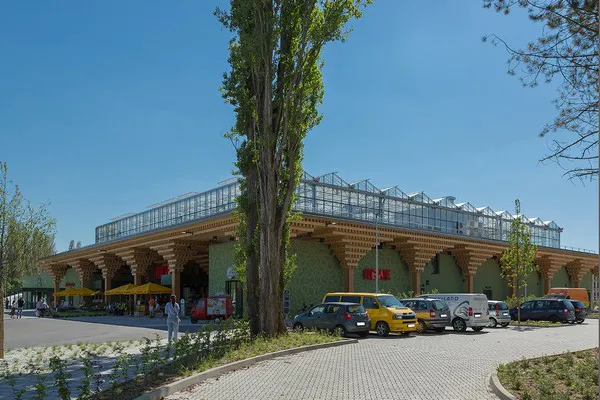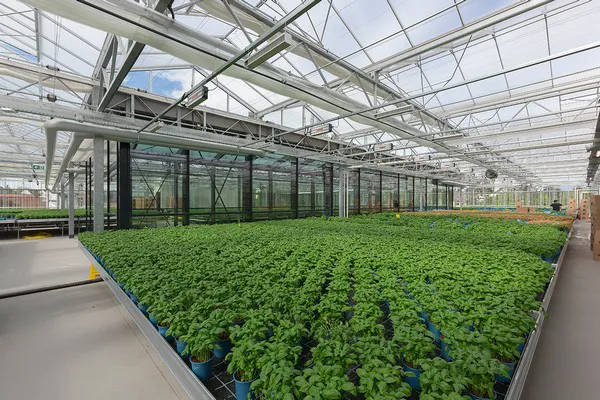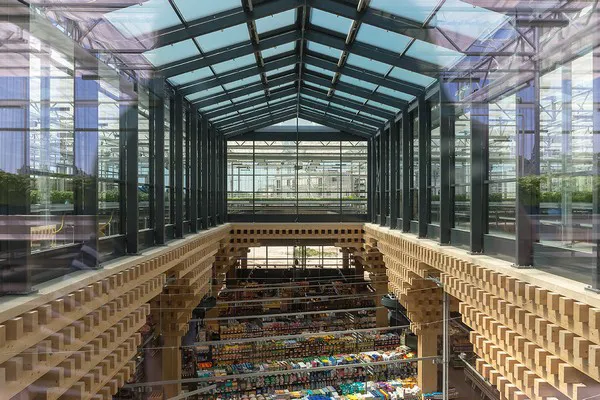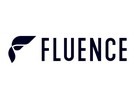A little over one year has passed since REWE retail chain launched ‘the supermarket of the future’: that is, a retail store with a greenhouse on the rooftop. While the rooftop greenhouse certainly catches the eye, there’s a lot more going on there. For instance, the structure is made out of wooden columns, and everything runs on 100% green energy. This rooftop greenhouse plus supermarket is the actualization of REWE’s plan of making grocery shopping an actual experience, with fruit and vegetable presented as if it was a farmers’ market. “This first pilot store was the first supermarket with a rooftop greenhouse in Europe,” says Nicolas Leschke from ECF, the company operating the greenhouse. In there, they grow basil in a mixture of hydroponics and aquaponics, making it a source not only of fresh herbs but of fish too. But what were the elements that made the rooftop greenhouse such a success? Of course, an utter focus on growing sustainably was a major one. At the same time, instrumental was the lighting solution they went for.
 © REWE Group
© REWE Group
A proven concept
Yet, the rooftop greenhouse wasn’t the first rodeo for ECF. The company indeed started off with a greenhouse project in Berlin some years ago. In there, they gained a lot of experience that they leveraged when it came to building and operating the rooftop greenhouse. “Initially, in our first greenhouse, we used narrow band (red and blue) lighting, but we weren’t happy with the results,” he points out. “We wanted to stand out in the market. I want our basil plants to smell good, to look healthy but also to be healthy. However, we noticed that plants didn’t appreciate the red spectrum much. But mainly, our beneficials didn’t like that kind of light.”
A better lighting
After all, the lighting system is one of the most crucial elements for any CEA facility, as growers need to walk a fine line between operational costs and environmental sustainability. “That’s why we have always used LEDs because the energy savings are significant,” Nicolas Leschke explains. But every grower knows that selecting a LED lighting system is not a matter of just consuming less energy. Rather, the quality of the spectrum is the key.
It was around that time that Nicolas went to the GreenTech in Amsterdam, Europe’s largest horticulture trade show. “It was four years ago when at the GreenTech, I saw Fluence. I was impressed by their broad white spectrum LEDs,” he says. “And I was also impressed by the knowledge and care that the Fluence team had in guiding me into making an informed decision. That’s why we decided to go with their fixtures and installed them in our greenhouse.” Thanks to the help of the Fluence team, Nicolas and ECF found the best way to install the Fluence VYPR top lights in their facility and obtain the best result possible. Thus, when ECF had to build a greenhouse on the rooftop of a REWE supermarket, they were already aware of all the elements necessary to make the project successful.
 © REWE Group
© REWE Group
Switching from a narrow (red and blue) spectrum to the Fluence broad white spectrum lighting system allowed ECF to meet the production goals both in terms of quality and quantity. “We work with the sunlight, too,” he explains. “In an exposed room, the spectrum might be different. With Fluence broad white spectrum LEDs, we can have a consistent spectrum all over the cultivation. In this way, we know for certain that our yield will be of a certain quality and quantity.” And for a supermarket of the future, having a constant supply of high-quality greens is paramount.
Sustainability is paramount
Equally paramount is environmental sustainability. While this involves the use of the most efficient lighting solution, it doesn’t end there. “We are showing how successful a short supply chain and circular economy can be,” Nicolas remarks. “This alone greatly reduces the carbon footprint compared to more traditional settings. At the same time, in the greenhouse, we have many processes that reduce the impact on our planet. For instance, we collect rainwater, have a fuel generator here, and our electricity comes solely from renewable resources.”
 © REWE Group
© REWE Group
The plans for REWE and ECF are long-term, and this new facility is just another step towards a future where they count on having 40 farms in the next 15 years. “But also to expand our farming model to include more crops,” Nicolas points out. “In terms of expansion, we want to export our model to more countries in Europe, as that’s the most logical next step and the easiest entry for us. At the same time, we are aware that the US is a great market, which can greatly benefit from a model like ours.”

